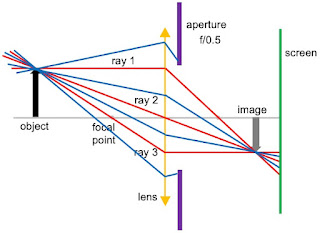Depth of Field and the F-Stop
Consider a simple optical system consisting of a converging lens, an aperture, and a screen to detect the image. This configuration looks like what you might find in a camera with the screen being film (oh, how 20th century) or an array of light detectors. Yet, it also could be the eye, with the aperture representing the pupil and the screen being the retina. We’ll consider a generic object positioned to the left of the focal point of the lens.
So far, we haven’t talked about the aperture. All three of our rays drawn in red pass through the aperture. Yet, these aren’t the only three rays coming from the object. There are many more, shown in blue below. Ones that hit the lens near its top or bottom never reach the screen because they are blocked by the aperture. The size of the blurry spot on the screen is specified by a dimensionless number called the f-stop: the ratio of the aperture diameter to the focal length of the lens. It is usually written f/#, where # is the numerical value of the f-stop. In the picture below, the aperture diameter is twice the focal length, so the f-stop is f/0.5.
Most photojournalists use fairly large f-stops, like f/8 or f/16, and a shutter speed of perhaps 5 ms. The human eye has an f-stop between f/2 (dim light) and f/8 (bright light). So, my illustrations above aren’t really typical; the aperture is generally much narrower.
Source: http://hobbieroth.blogspot.com/2024/07/depth-of-field-and-f-stop.html
Anyone can join.
Anyone can contribute.
Anyone can become informed about their world.
"United We Stand" Click Here To Create Your Personal Citizen Journalist Account Today, Be Sure To Invite Your Friends.
Lion’s Mane Mushroom Nootropic
Mushrooms are having a moment. One fabulous fungus in particular, lion’s mane, may help improve memory, depression and anxiety symptoms. They are also an excellent source of nutrients that show promise as a therapy for dementia, and other neurodegenerative diseases. If you’re living with anxiety or depression, you may be curious about all the therapy options out there — including the natural ones.Our Lion’s Mane WHOLE MIND Nootropic Blend has been formulated to utilize the potency of Lion’s mane but also include the benefits of four other Highly Beneficial Mushrooms. Synergistically, they work together to Build your health through improving cognitive function and immunity regardless of your age. Our Nootropic not only improves your Cognitive Function and Activates your Immune System, But it benefits growth of Essential Gut Flora, further enhancing your Vitality.
Our Formula includes: Lion’s Mane Mushrooms which Increase Brain Power through nerve growth, lessen anxiety, reduce depression, and improve concentration. Its an excellent adaptogen, promotes sleep and improves immunity.
Shiitake Mushrooms which Fight cancer cells and infectious disease, boost the immune system, promotes brain function, and serves as a source of B vitamins.
Maitake Mushrooms which regulate blood sugar levels of diabetics, reduce hypertension and boosts the immune system.
Reishi Mushrooms which Fight inflammation, liver disease, fatigue, tumor growth and cancer. They Improve skin disorders and soothes digestive problems, stomach ulcers and leaky gut syndrome.
Chaga Mushrooms which have anti-aging effects, boost immune function, improve stamina and athletic performance, even act as a natural aphrodisiac, fighting diabetes and improving liver function.
Try Our Lion’s Mane WHOLE MIND Nootropic Blend 60 Capsules Today. Be 100% Satisfied or Receive a Full Money Back Guarantee. Order Yours Today by Following This Link.











